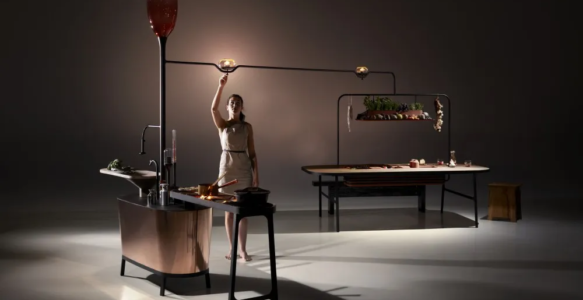In the realm of architecture and design, the integration of biological principles is not just a trend but a necessity to foster a sustainable and healthy environment. Inspired by several innovative projects, we envision a future where homes are not only shelters but active participants in energy production, waste management, and environmental restoration. Here, we delve deeper into the potential of bio-inspired home designs and their benefits for the environment and human life quality.
1. Living Light by Ermi Van Oers
Imagine a world where your houseplants are more than just decorative elements. Ermi Van Oers’s Living Light proposes using plants as natural energy sources. By employing microbial fuel cells, these designs can harness the chemical energy from plant photosynthesis to power household lights. This approach not only provides a sustainable energy solution but also enhances indoor air quality, promoting a healthier living environment.

2. The Hy Fi Project by The Living
This temporary installation showcased the possibilities of organic and reflective materials in construction. Utilizing corn stalks and mycelium, the organic bricks demonstrated how agricultural waste could be transformed into viable building materials. The project highlighted the circular life cycle of materials, where after their useful life, they were returned to the earth as nutrients. This method reduces waste and supports local ecosystems.



Image: Hy-Fi – urbanNext
3. Self-Healing Bio-Concrete
Henk Jonkers’ bio-concrete introduces self-healing properties into traditional concrete through the use of Sporosarcina pasteurii bacteria. This innovative material can repair its own cracks, significantly extending its lifespan and reducing maintenance costs. The eco-friendly nature of this concrete lessens the environmental impact of construction projects by reducing the need for new materials and decreasing carbon emissions associated with building repair.

Image: [PDF] Bacteria-based self-healing concrete | Semantic Scholar
4. BioMason’s Bricks
BioMason’s technology revolutionizes brick production by eliminating the high energy costs associated with firing traditional clay bricks. By using microorganisms to bind sand into durable bricks, this method mimics natural coral formation, offering a significant reduction in carbon emissions. The adoption of such technology could transform construction norms, promoting a shift towards more sustainable practices.
5. Microbial Home System by Philips
The Microbial Home System proposes a zero-waste ecosystem within the home, where each element’s waste is another’s resource. Features like a bio-digester kitchen island and an evaporative cooler integrated into a dining table represent a holistic approach to household design. This system manages waste efficiently and provides renewable energy and food preservation solutions, creating a sustainable living environment that mimics natural ecosystems.



Image: The Microbial Home – misfits’ architecture (misfitsarchitecture.com)
Envisioning a New Bio-Inspired Home
A future bio-inspired home could integrate these technologies to create a living environment that is almost entirely self-sustaining. Such homes would produce their own energy, manage waste organically, and continuously adapt to their inhabitants’ needs while mitigating their environmental impact. The potential benefits include reduced energy costs, lower carbon footprints, and a healthier living environment that actively contributes to the restoration and preservation of the natural world.
As architects and designers, it is crucial to pioneer these changes, embracing an integrated approach to design that blurs the lines between biology and architecture. By doing so, we can significantly improve both the quality of human life and the health of our planet. This shift towards bio-design is not just a possibility—it is becoming an imperative.
For Further Learning: Rebooting… to Bio-Design! – RTF | Rethinking The Future (re-thinkingthefuture.com)

